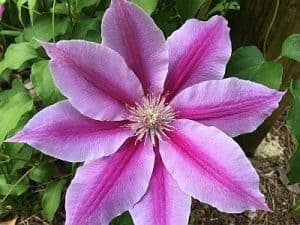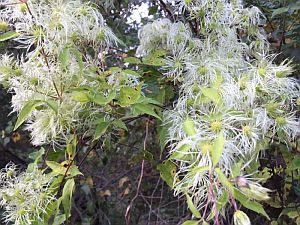
Clematis species/Clematis Native
Clematis is a member of the Ranunculaceae family, which has more than 300 species and hundreds of hybrids. Clematis species is an herbaceous vine which is deciduous and is often called “Queen of the Vines, Queen of the Climbers” because of its’ showy flowers. It is among the most popular vines in the upper South. While it is more superior grown in the upper South, it is still worth any effort here in the lower South. Clematis create a colorful show in the garden on walls, arbors, trellises and even in pots. Hummingbirds and butterflies love Clematis.
There is a Clematis for every garden and flower for almost every month of the year. Flowers from February/March until frost. Heights and spread varies depending on the plant. Aggressive species may grow to 30 feet. Most large flowered hybrids grow 8-12 feet and smaller herbaceous species grow 2 to 5 feet.
Clematis have 3 general flower forms: small white flowers in loose clusters; bell or urn-shaped flowers; and flat or open flowers. The flower colors are a wide range of deep and pale shades of red, pink, purple, blue and white. The showy fruit are bell-shaped, feathered structures. Many species have fragrant blooms but most hybrids do not have fragrance. Small flowered species offer fragrances of almond to hot cocoa. Blooms and seed pods make interesting cut arrangements.
For best results, Clematis species prefer their heads in the sun and their feet in the shade. Keep the roots cool and shaded by other plants or add a thick layer of mulch at the base to protect the root system from cold. The best floral performance and disease resistance is usually achieved when this vine is planted in south facing positions. Clematis will not flower well in shade.
Prepare the planting area with fertile, organically rich and well-drained soil. Clematis prefer a neutral to slightly alkaline soil pH. Amend any clay soil with organic matter and use a bit of slow release fertilizer at planting. Plant at the same depth it was growing in the container or pot. Put your support in place at planting and gently place stems on support as stems break easily but this plant is not easily damaged. Water requirements are average. Feed established plants in late winter and again in late summer.
Minimal to no pruning is needed on these vines as they are very easy to contain and not aggressive in our area. I often don’t think about pruning mine and it does just fine. But the general rule is, if your Clematis blooms in Spring (April or May on old wood), prune it immediately after flowering. If your Clematis blooms in Summer (June on old wood and later in the summer on new growth), prune in winter, cutting back hard to 2 or 3 feet always leaving a few growth buds. Some say they will get another flush of flowers after pruning. I’ve not had to do this because my plant dies back in the winter and miraculously reappears again in Spring.
A few of the many popular Clematis for our area are; Crimson King’ – has large crimson-red flowers. ‘Duchess of Edinburgh’- has large white lowers, fragrant blooms on previous season’s growth. “Henryi’- has creamy-white flowers with dark stamens, each 6 to 8 inches across. The most popular white. ‘Nelly Moser’ – a soft pink with wide, darker pink stripes. Blooms several times during season. Clematis x jackmanii– has large purple flowers. May be the most popular as it is very dependable.
Clematis crispa or Swamp Leather Flower is a native species of our area. C. crispa is a long-lived perennial vine which goes dormant in winter. Like the species Clematis, grow C. crispa on a trellis or support as it can reach 6 feet. It performs best in part sun, part shade. PH is adaptable. This clematis has the single bell-shaped blooms which are pinkish-purple. Found on sites with alluvial soil, this plant has showy, interesting flowers and is fragrant. Birds and small wildlife consume the seeds. It is a host for the mournful thyris, (Thyris sepulchralis). Propagation by cuttings and division is recommended as seeds may take several years to germinate. Plant in rich somewhat sandy soil.
Submitted by Karen Blackburn




